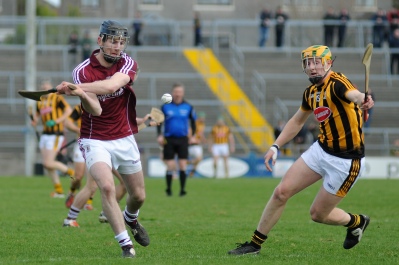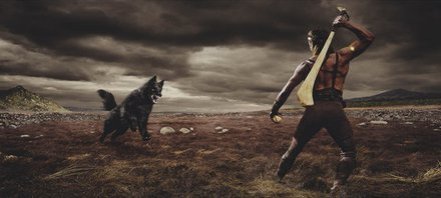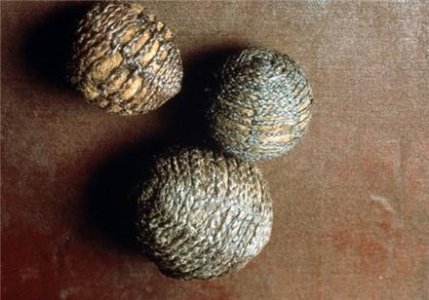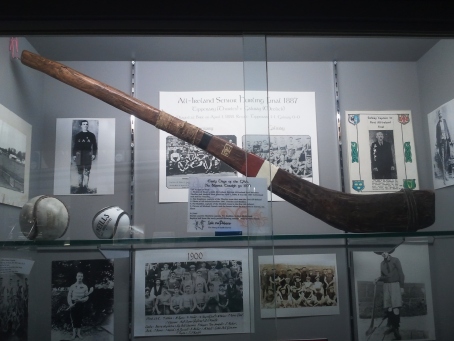
Padraig Mannion (Galway – maroon* shirt), John Power (Kilkenny – black and amber shirt) in the Allianz National Hurling League game earlier this year. (When first published, the colour given here for the Galway shirt was ‘burgundy.’ However, I have been advised that the official colour is maroon. I must have been thinking of the 16th century wine trade between Galway and Spain!)
When does the autumn (the Fall to you North Americans) begin? Traditionally in Ireland it started on the first day of August. A meteorologist would state 1st September is the scientific date. Parents would suggest it starts when the children go back to school (this year some schools opened during the last full week in August!). But more and more in Ireland it seems to be the first Sunday in September, that is 6th September this year. All because of a hurling match.
As noted last year, the first Sunday in September is sacrosanct in hurling circles in Ireland – it’s the date of the All Ireland Hurling Championship Final in Croke Park, Dublin. This year’s final will be contested between last year’s winners Kilkenny (known as the ‘Cats’) and Galway (the ‘Tribesmen’). Having shocked everybody by defeating Tipperary in a thrilling semi-final, Galway are very welcome contestants for Kilkenny – and I’m saying this as a Corkman! Much as I admire Kilkenny, I feel the time has come for somebody to snatch the Liam McCarthy Cup away from them, if only to keep them on their toes!.Besides they’ve won that trophy seven times in the last nine years. Galway are aspiring to prise Kilkenny’s grip from the McCarthy cup for their first title since 1988! For this match, neutrals will be as rare as hen’s teeth.

The nobleman Culainn had a ferocious guard hound (cu) that was killed by the boy Setanta who struck a sliotar (hurling ball) down the hound’s throat. Setanta then offered to become Culainn’s new guard hound. Hence the name he was given – Cu Chulainn, or Culainn’s Hound. Hurling is still a game that creates near mythical heroes.
The weather forecast looks good – dry and sunny with some small risk of showers hater (hopefully MUCH later). We’re enjoying something of an Indian summer at present although the temperatures are not exceptional. It’s dry – that’s all that matters!
For anyone who has never seen a game of hurling, I’d say, if you’re visiting Ireland during the summer months – go and watch a local club game! You may not understand it, but someone will try (and usually fail) to explain it to you. Or better, watch a major championship match on television. It’s unlikely you’d get a ticket to the big games – they get snapped up instantly. And remember the players are ALL ‘amateurs’ – that is they are not on a salary of any kind and yet they boast fitness levels that would rival that of most professional footballers on six figure sums. They play for pride of club, parish or county and for the honour of being a hero – in the true Corinthian spirit.

Made of matted cow hair with a horsehair covering, these early sliotars (hurling balls) are very different from the modern cork and leather sliotars. The earliest dates from the later twelfth century – between 1150 and 1200! The English tried to suppress hurling but its modern revival dates from the spread of the Gaelic Athletic Association in the 1880s.
Our official national festival is St Patrick’s Day, but to see 80,200 intermingled fans in Croke Park screaming on their respective counties probably gives a better indication of Ireland’s entrenched localism. There is a very real claim that the game is some 2,000 years old, with the modern rules being formulated in 1881, But it seems that the passions aroused by the game haven’t aged one bit – there’s life in this old game yet!

Hurley used by Pat Madden of Meelick in the 1887 All Ireland Hurling Final against Thurles. The modern hurley is somewhat more ergonomic, but every bit as deadly on the field of play.
Kikenny won’t have the mighty Henry Shefflin, who has retired. Not that they missed him – they have so many good players. Galway have already beaten Kikenny in the Allianz Hurling League and will play the irrepressible Joe Canning. Who is likely to win? It’s genuinely difficult to say, but I’m rooting for Galway!
The “official” Galway colour is maroon
LikeLiked by 1 person
Thanks, Cathal. That reference to ‘burgundy’ was entirely my own mistake. I must have been thinking of the large wine trade between Galway and Spain in the sixteenth century.
LikeLike
Nice save Tony.
LikeLike